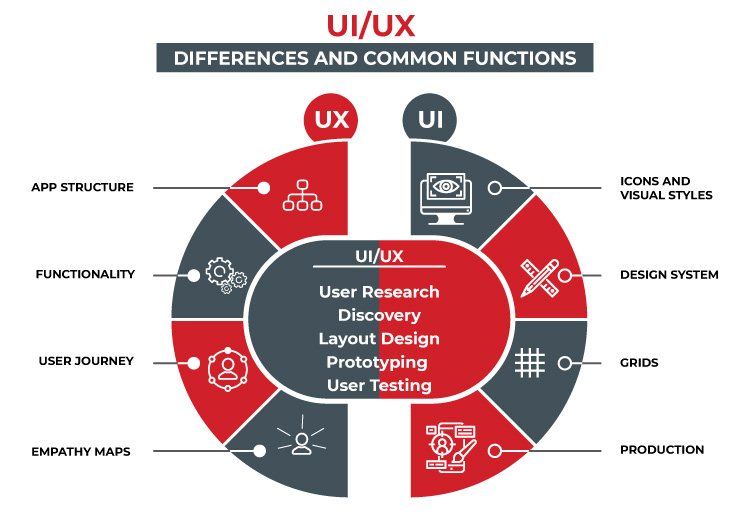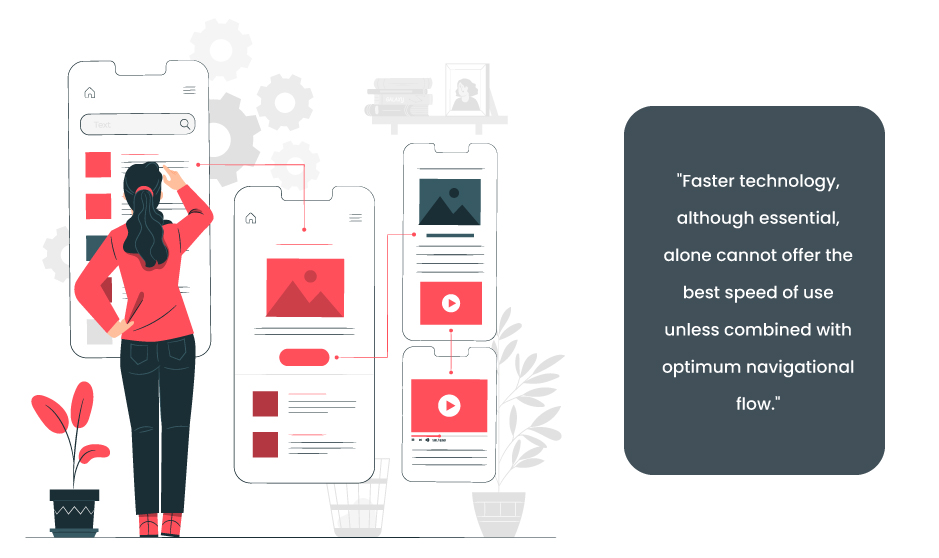If you pulled up your phone’s App Store or Play Store now, you’d find millions of applications in almost every conceivable category of business, arts, entertainment, news or healthcare, vying for your attention, competing for a download click. As a user, you no doubt have experimented with multiple app products yourself – researching, installing, testing, uninstalling and then starting all over again – to find an app worthy of space on your phone. So, what is it that some apps have, and others don’t that make them popular, even if they all served the same basic functionalities?
The entire approach for mobile app development has come a long way from creating products that simply perform to designing immersive and emotionally satisfying customer experiences. This is why mobile app developers today work in-sync with UI/UX designers to ensure that their products look and feel as special as their technical features. In this blog let’s dig deeper into the significance of User Interface (UI) and User Experience (UX) design and see how their effective integration during product building can help businesses and entrepreneurs.
What is UI in Mobile App Development?
To put it in simple terms, UI designs determine how a mobile application should function. It ensures the app is easy to use and intuitive for its users. Everything that a user sees on the screen while interacting with a mobile app falls under UI. It is the responsibility of the UI designers to detail the overall presentation of the app including navigation menus, screen sizes and application of brand colors. Experienced UI teams follow the latest design principles and brand identity guidelines to create a seamless and immersive experience for their users.
What is UX in Mobile App Development?
UX on the other hand is all about enhancing the experience of a user while interacting with the app, ensuring a frustration-free experience. It involves meticulous research on the requirements of the target audience and mapping those into the most ideal user journey in order to construct efficient navigational pathways within the app. It is a painstaking process that involves multiple iterations, prototyping and testing for every single user touchpoint. The ultimate goal for UX designers (or developers) is to make the app experience truly immersive, engaging and satisfying for the user. Mobile apps with a great UX succeed in bringing customers back for longer and more frequent sessions.

Information source: https://www.eleken.co/blog-posts/ui-ux-designer-vs-front-end-developer
Why is UI/UX important in Mobile App Development?
Now that we understand what UI and UX mean, let’s look at how they play a huge role in determining the success or failure of mobile apps. The important thing to remember is that both UI and UX are functions that must support each other and that one cannot perform well without the other. This is why software development companies refer to UI/UX as something that needs to be addressed together and not individually.
The best user journeys make for winning apps
From understanding what “Tom” or “Mary” is looking for when he/she opens an app to how quickly the app solves his/her problems, defining user journeys is a crucial part of developing great UX designs. Companies carry out extensive competitive analyses and research on user personas early on in product development to arrive at the most ideal user journeys. The process helps teams to identify the real issues and hidden opportunities in existing product alternatives – knowledge that is then used to optimize the navigational flow within the application. A mobile app that offers customers exactly what they want is easily preferred more and is likely to be used frequently.
Businesses grow when users stay
Companies that launch a new app can only go so far with app download marketing. In the end, if a user decides to uninstall after their initial interaction, the company will suffer heavily. Businesses with a mobile-first strategy can only hope to grow if they take UI/UX very seriously. Giving users the best experience when they interact with an app is the only way to ensure that application investments yield long-term results. And it isn’t a one-time affair either. Consumer behavior is constantly changing, shaped by new information, experiences and content/services made easily accessible across regions and cultures. Therefore, product developers need to ensure that their apps are updated not just in its technical capacity but also in its user experience touchpoints, giving app customers every reason to stay and not switch to something new and better.
Creating brands that leave an impact
Mobile apps are the fastest way to deliver brand communications in the digital era and a lot of this rides on interface design aesthetics, presentation and app usability – all elements of UI/UX. Successful brands need their applications to do more than just look and feel color-coordinated. They need their apps to communicate their brand mission and values to their customers in a subtle yet impressive manner. For instance, a ride sharing app must have a UI/UX focused on functionality, quick accessibility, alerts, and easy payments, – not extensive (and time consuming) animation graphics or a tall order of the types of vehicles available and the areas they service. Mobile apps with UX designed around the brand’s unique selling proposition eventually build better customer loyalty and trust.
UI/UX improvements that optimize efficiency
Everyone knows that faster and better performing apps have a more favorable standing in today’s market. But did you also know that UI/UX plays a critical role in enhancing app performance? The speed of use is a usability trait that determines how soon the app can complete a task or a set of tasks requested by a customer. Faster technology, although essential, alone cannot offer the best speed of use unless combined with optimum navigational flow. If product development happens in sync with UX strategies like creating larger target areas or minimizing pointer movements, applications can increase their speed and efficiency to a great extent.

Business decisions banking on user testing
User testing is one of the most pivotal stages in any UX process. Not only does it allow developers to evaluate the strengths and failures of the mobile application, but it also brings to table valuable insights in the form of feedback from real users. This information can be used to improve the existing product. Although the process may require your product to remain in the workshop for longer than you would have wanted, the long-term benefits of user testing far outweigh the short-term inconveniences. For one, businesses save a lot of money and time by ensuring that only a fully tested and ready-for-market product is released to the world. Moreover, user testing helps brands maintain their reputation for quality and reliability.
UI/UX at Expeed Software
In conclusion, it’s safe to say that the future of businesses driven by mobile apps will rely heavily on innovations in UI/UX just as much as in technology. The UI/UX team at Expeed follows a tried and tested UX design process that ensures the most engaging and emotionally satisfying customer experience for our mobile applications. We are committed to creating apps that people can fall in love with and offer exceptional user experiences.
The post Why UI/UX is essential for Mobile App Development appeared first on Expeed Software | Trustworthy Software Solutions.
This content was originally published here.


